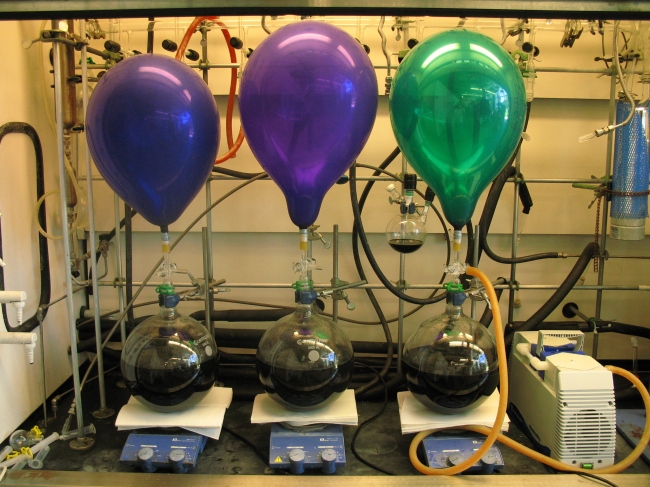
Sodium sulfate 213.0 g (anhydrous, 3.0 mol of Na) was gradually added into a stirred slurry of Al2(SO4)3 .18H2O 1000g (3.0 mol of Al) in D.I. water 2L and the mixture was stirred to complete dissolution (about 30 min). The total volume was adjusted by addition of D.I. water to 2.7L and the solution was filtered through a fine porosity filter. The obtained 1.1M solution of NaAl(SO4)2 was combined with 226.9g of the Cs salt (350 mmol) in a large 4L beaker. Solid CsCl 6g was added to the stirred mixture, to seed the formation of cesium alum CsAl(SO4)2.12H2O crystals. The mixture was stirred in open Erlenmeyer flask at ambient temperature for 30 hours. During this time, the red-brown slurry of the cesium salt turned into coffee-brown black slurry of the sodium salt intermixed with fine white salt-like crystals of cesium alum. The solids were collected by filtration, rinsed thoroughly with saturated (=1.5M) aqueous sodium sulfate solution (in three portions 3 x 0.5L until the filtrates were colorless) and the obtained filter cake wet with sodium sulfate solution was dried by suction, and then in vacuo for 1 day, until completely dry free-flowing material was obtained. The solids were transferred into a 2L wide-mouth Erlenmeyer flask, 700mL of acetonitrile was added and the mixture was stirred mechanically for 15 min [Note 1]. The resulting deep orange slurry was filtered on a medium porosity Buchner funnel, the cake of insoluble sulfate salts was rinsed with additional acetonitrile (3x100mL until colorless) and was discarded. The combined orange filtrates in a 5L round flask were diluted with MTBE 4L (added in four 1L portions with gentle stirring), the flask was then set aside for 30 min to complete the precipitation. The precipitated crude sodium salt was collected by filtration, rinsed thoroughlt with MTBE (2×0.5L) and dried by suction and then in vacuo.
The crude product, 190.4g of a fluffy brown solid (retaining solvent residues and Cs, about 2500-4000 ppm Cs) was transferred into a dry 10L round flask. 191 g of powdered activated molecular sieves 4A [Aldrich 688363, sodium aluminosilicate, SYLOSIV A4 manufactured by Grace Davidson] was added to the flask followed by methyl ethyl ketone 4.2L. With stirring on high speed (800rpm), methanol 600mL was gradually added into the slurry over a 5 min period. The stirring was continued for 30 min, at this time nearly all dark brown lumps of the material dissolved. The resulting orange slurry was filtered through a fine porosity 3L large Buchner funnel [Note 1]. The spent molecular sieves were thorougly rinsed with additional MEK (2x200mL) and discarded. The combined filtrates were precipitated by a gradual addition of MTBE 10L with mechanical sitrring. After complete MTBE addition, the stirring was turned off and the material was allowed to precipitate for additional 30min. The solids were collected by filtration and rinsed thoroughly with MTBE (2×0.5L) and dried by suction. The purified product 184g, containing solvate-bound MTBE, was combined with 3.3L of wet MTBE (prepared by shaking 4L of MTBE with water 50mL in a closed flask, for 30min, and decanting water-saturated MTBE from the water droplets). The mixture was stirred in open 5L wide mouth Erlenmenyer for 40 min. The brown solids were collected by filtration, rinsed with wet MTBE, dried by suction [Note 2] and then then in vacuo overnight (15h). The yield was 176.1g of a heavy dark brown granular solid (93.5% of theory), with HPLC purity 98.7% and a matching elemental analysis. The Cs content was below 100 ppm. There was no MTBE residual odor.
Note 1: The solvolysis with acetonitrile and also with methanol leads to a formation of detectable decomposition products on the timescale of hours. The filtration and precipitation needs to be performed immediately as the material is rather unstable in solution.
Note 2: The product has a tendency to retain organic solvent residues. A re-slurry with wet MTBE transforms the solvates into a more stable dihydrate. There is a second, metastable orange-red dihydrate polymorph that forms temporarily from MTBE-solvated product upon exposure to moist air. A sudden appearance of orange-red particles within the brown-black filter cake of the product during the final filtration is an indication that the material was not fully hydrated and retains still some MTBE solvate. The problem is fixed by repeating the re-slurry in wet MTBE.


